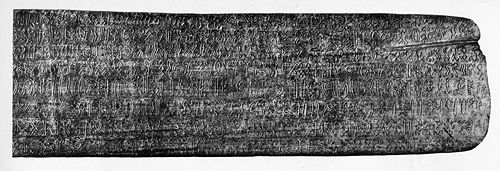
Rongorongo text A
Encyclopedia

Rongorongo
Rongorongo is a system of glyphs discovered in the 19th century on Easter Island that appears to be writing or proto-writing. It cannot be read despite numerous attempts at decipherment. Although some calendrical and what might prove to be genealogical information has been identified, not even...
corpus, also known as Tahua, is one of two dozen surviving rongorongo texts.
Other names
A is the standard designation, from BarthelThomas Barthel
Thomas Sylvester Barthel was a German ethnologist and epigrapher who is best known for cataloguing the undeciphered rongorongo script of Easter Island....
(1958). Fischer (1997) refers to it as RR1.
It is also known as the Oar (la rame), the object from which it was made.
Location
General archives of the Padri dei Sacri CuoriCongregation of the Sacred Hearts of Jesus and Mary
The Congregation of the Sacred Hearts of Jesus and Mary and of the Perpetual Adoration of the Most Holy Sacrament of the Altar is a Roman Catholic religious order of brothers, priests, and nuns...
(SSCC), Casa Generalizia, Via Rivarone 85, I-00166 Rome, Italy.
Reproductions are located at the SSCC; the Bishop Museum
Bishop Museum
The Bishop Museum , is a museum of history and science in the historic Kalihi district of Honolulu on the Hawaiian island of O'ahu...
, Honolulu; and the Cinquantenaire
Cinquantenaire
Parc du Cinquantenaire or Jubelpark is a large public, urban park in the easternmost part of the European Quarter in Brussels, Belgium....
, Brussels.
Physical description

Provenance
One of Jaussen'sFlorentin-Étienne Jaussen
Monsignor Florentin-Étienne Jaussen was the first bishop of Tahiti and the man who brought the rongorongo script of Easter Island to the world's attention. In the 1860s Bishop Jaussen was responsible for ending the slave raids on Easter Island.Jaussen was born in Rocles, France...
tablets, Tahua was apparently collected on Easter Island
Easter Island
Easter Island is a Polynesian island in the southeastern Pacific Ocean, at the southeasternmost point of the Polynesian triangle. A special territory of Chile that was annexed in 1888, Easter Island is famous for its 887 extant monumental statues, called moai, created by the early Rapanui people...
by Fathers Roussel
Hippolyte Roussel
Hippolyte Roussel was a French priest and missionary to Polynesia, a member of the Congregation of the Sacred Hearts of Jesus and Mary.In 1854 he was sent to evangelize in the Tuamotus and Mangareva in the Gambier Islands...
and Zumbohm in 1870 and sent to him in Tahiti. It was sent to the headquarters of the Congrégation des Sacrés-Coeurs et de l'Adoration (SSCC) in Paris, where it was deposited in the Missionary Museum, either by Jaussen in 1888 or by the French navy in 1892 after his death. In 1905 it was moved to the SSCC museum in Braine-le-Comte
Braine-le-Comte
Braine-le-Comte is a Walloon municipality located in the Belgian province of Hainaut.On January 1, 2006, Braine-le-Comte had a total population of 20,305...
, Belgium. In 1953 it followed the SSCC to Grottaferrata
Grottaferrata
Grottaferrata, Italy is a small town and comune in the province of Rome, situated on the lower slopes of the Alban Hills, 20 km south east of Rome. It is bounded by other communes, Frascati, Rocca di Papa, Marino, and Rome.-History:...
, near Rome, and in 1964 to Rome itself. In 1974 the SSCC moved to its permanent headquarters in Rome.
Contents
The proper starting point of the inscription is unclear. (Jaussen's informant Metoro Tau‘a Ure 'read' it starting with side b.) Kudryavtsev discovered that several lines of Tahua were paraphrased on the Large St. Petersburg tabletRongorongo text P
Text P of the rongorongo corpus, the larger of two tablets in St Petersburg and therefore also known as the Great or Large St Petersburg tablet, is one of two dozen surviving rongorongo texts, and one of three recording the so-called 'Great Tradition'.-Other names:P is the standard designation,...
(tablet P).
Barthel (1958) noted sections of the Taure text repeated, in seemingly random distribution, on tablets B Aruku
Rongorongo text B
Text B of the rongorongo corpus, also known as Aruku Kurenga, is one of two dozen surviving rongorongo texts.Aruku Kurenga provided part of the "Jaussen List", a failed key of rongorongo glyphs...
, C Mamari
Rongorongo text C
Text C of the rongorongo corpus, also known as Mamari, is one of two dozen surviving rongorongo texts. It contains the Mamari Calendar.-Other names:C is the standard designation, from Barthel...
, E Keiti
Rongorongo text E
Text E of the rongorongo corpus, also known as Keiti, is one of two dozen known rongorongo texts, though it survives only in photographs and rubbings.-Other names:E is the standard designation, from Barthel...
, H Large Santiago
Rongorongo text H
Text H of the rongorongo corpus, the larger of two tablets located in Santiago and therefore also known as the Great or Large Santiago tablet, is one of two dozen surviving rongorongo texts, and one of three recording the so-called 'Great Tradition'.-Other names:H is the standard designation, from...
, P Large St Petersburg
Rongorongo text P
Text P of the rongorongo corpus, the larger of two tablets in St Petersburg and therefore also known as the Great or Large St Petersburg tablet, is one of two dozen surviving rongorongo texts, and one of three recording the so-called 'Great Tradition'.-Other names:P is the standard designation,...
, and Q Small St Petersburg
Rongorongo text Q
Text Q of the rongorongo corpus, the smaller of two tablets in St Petersburg and therefore also known as the Small St Petersburg tablet, is one of two dozen surviving rongorongo texts, and one of three recording the so-called 'Great Tradition'....
. Butinov (1959:74) suggested that Tahua might contain a genealogy.
Text
There are eight lines of glyphs on each side, with a total of ~ 1,825 glyphs. Through comparison of phrases shared with other texts, Pozdniakov has established that the reading order of the lines follows Barthel, though the order of the two sides may still be either a–b or b–a.Barthel
Fischer

